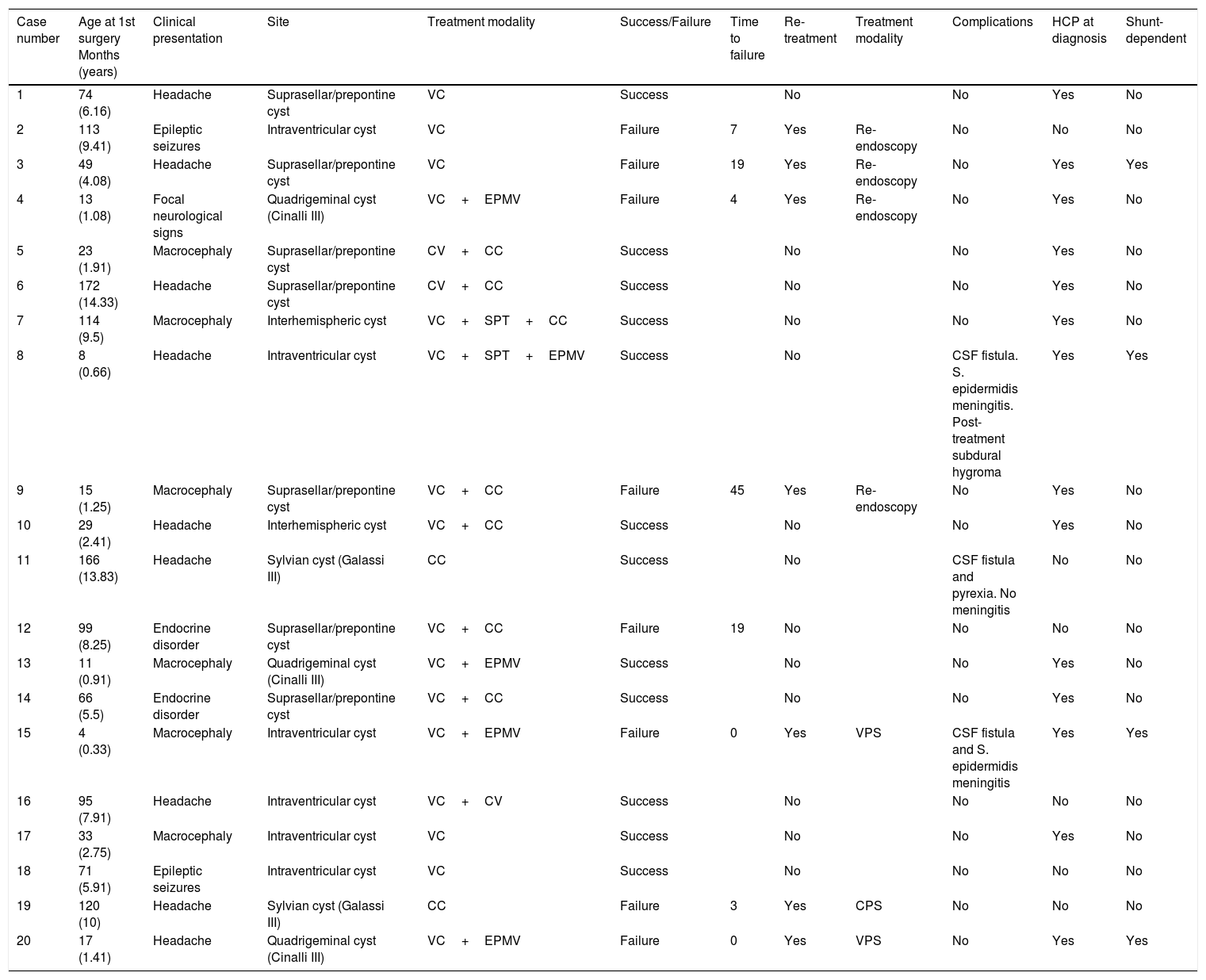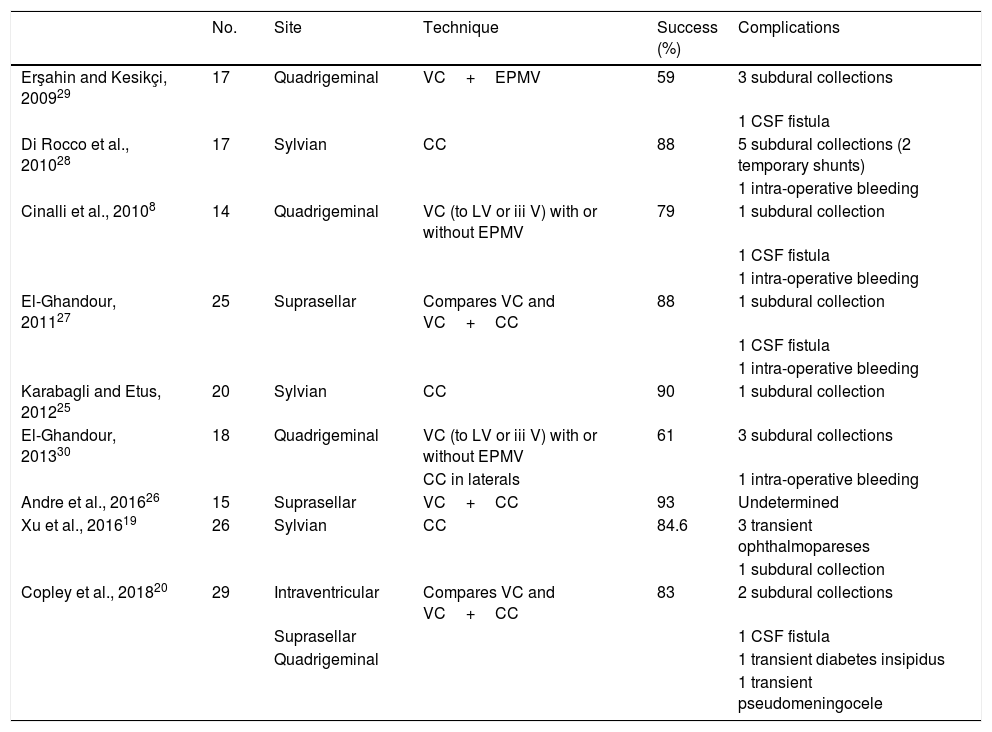Neuroendoscopy has become an effective and safe treatment for arachnoid cysts in the paediatric population. We review the paediatric patients with arachnoid cysts treated by neuroendoscopy in our hospital and analyse the results.
Material and methodsA retrospective analysis of 20 patients operated on from 2005 to 2018. The variables assessed are: gender, age, clinical presentation, cyst site, presence of hydrocephalus and/or extra-axial collections, endoscopic procedures and complications. Procedure success is defined as an improvement in symptoms and reduction in cyst size until end of follow-up.
ResultsOur series comprised 13 males and 7 females (mean age: 64.6 months, range: 4–172 months). The most frequent site was suprasellar-prepontine (7), followed by intraventricular (6), quadrigeminal (3), interhemispheric (2) and Sylvian (2).
A total of 70% (14/20) of patients had hydrocephalus at diagnosis, which increased to 85% in suprasellar-prepontine cysts and 100% in quadrigeminal cysts. Only 4/14 patients with required a ventriculoperitoneal shunt (median age at diagnosis: 12.5 months). Of these 4 patients, 3 developed severe shunt overdrainage.
The procedure was successful in 60% (12/20) of the patients in the series. Success by location was 57% (4/7) in suprasellar cysts, 33% (1/3) in quadrigeminal cysts, 66% (4/6) in intraventricular cysts, 100% (2/2) in interhemispheric cysts and 50% (1/2) in Sylvian cysts. Treatment thus failed in 8 cases, with a mean time to failure of 12.12 months (range: 0–45 months). A new neuroendoscopic procedure was performed in 4 of these 8 cases (success in 2/4), a ventriculoperitoneal shunt was placed in 2 cases, a cystoperitoneal shunt was placed in 1 case and the remaining case was managed conservatively. Mean follow-up time was 52.45 months (range: 3–129 months).
ConclusionsNeuroendoscopy is an effective and safe treatment for arachnoid cysts in paediatric patients that also enables managing associated hydrocephalus in most cases. The choice of neuroendoscopic procedure and success rate depend on cyst location. Younger patients have been found to have a higher shunt dependency rate. In these cases, measures to prevent shunt overdrainage are recommended.
La neuroendoscopia se ha posicionado como un tratamiento eficaz y seguro en los quistes aracnoideos en la edad pediátrica. Realizamos una revisión de los pacientes pediátricos con quistes aracnoideos tratados mediante neuroendoscopia en nuestro servicio y analizamos los resultados.
Materal y métodosAnálisis retrospectivo de una serie de 20 pacientes intervenidos entre el año 2005 y 2018. Las variables recogidas son: género, edad, presentación clínica, localización del quiste, presencia de hidrocefalia y/o colecciones extra-axiales, maniobras endoscópicas realizadas y complicaciones. Se consideró éxito del procedimiento cuando se produjo mejoría de los síntomas y reducción del tamaño del quiste, manteniéndose esta situación hasta final de seguimiento.
ResultadosLa serie consta de 13 varones y 7 mujeres (edad media: 64.6 meses; rango 4–172 meses). La localización más repetida fue supraselar/prepontina (7), seguida de intraventricular (6), después cuadrigeminales (3), interhemisféricos (2) y silvianos (2).
Un 70% (14/20) de pacientes asociaba hidrocefalia en el momento del diagnóstico, elevándose hasta el 85% en quistes supraselares/prepontinos o el 100% en cuadrigeminales. Sólo 4/14 pacientes precisaron un sistema de derivación ventriculoperitoneal (mediana de edad al diagnóstico: 12.5 meses). De estos 4, 3 desarrollaron un sobredrenaje valvular grave.
Se consideró éxito del procedimiento en 12/20 pacientes (60%) de la serie. Diferenciando por localización: 4/7 en supraselares (57%), 1/3 en cuadrigeminales (33%), 4/6 en intraventriculares (66%) 2/2 en interhemisféricos (100%) y 1/2 en silvianos (50%). Por tanto, se registraron 8 fallos de tratamiento, con un tiempo medio hasta el fallo de 12.12 meses (rango: 0–45). De esos 8 pacientes, en 4 se realizó una nueva neuroendoscopia (éxito de 2/4), en 2 casos se optó por la colocación de derivación ventriculoperitoneal, en 1 caso por la colocación de derivación cistoperitoneal y en el restante se mantuvo una actitud conservadora. El seguimiento medio fue de 52.45 meses (rango 3–129 meses).
ConclusionesEl tratamiento neuroendoscópico es efectivo y seguro en el tratamiento de los quistes aracnoideos en edad pediátrica, permitiendo además en muchos casos el control de la hidrocefalia asociada. El tipo de procedimiento neuroendoscópico y el porcentaje de éxito depende de la localización del quiste. Se observa una tendencia de mayor dependencia valvular en pacientes de menor edad. En esos casos, sería recomendable la aplicación de medidas de prevención de sobredrenaje.
Article

If it is the first time you have accessed you can obtain your credentials by contacting Elsevier Spain in suscripciones@elsevier.com or by calling our Customer Service at902 88 87 40 if you are calling from Spain or at +34 932 418 800 (from 9 to 18h., GMT + 1) if you are calling outside of Spain.
If you already have your login data, please click here .
If you have forgotten your password you can you can recover it by clicking here and selecting the option ¿I have forgotten my password¿.











